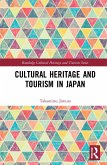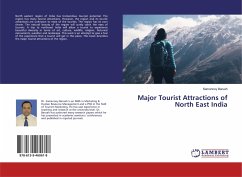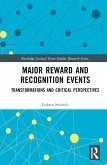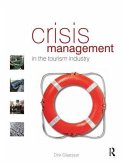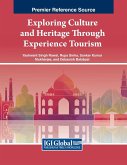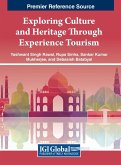Adi Weidenfeld, Richard Butler, Allan M. Williams
Visitor Attractions and Events
Locations and linkages
Adi Weidenfeld, Richard Butler, Allan M. Williams
Visitor Attractions and Events
Locations and linkages
- Gebundenes Buch
- Merkliste
- Auf die Merkliste
- Bewerten Bewerten
- Teilen
- Produkt teilen
- Produkterinnerung
- Produkterinnerung
This book for the first time theoretically and empirically explores the relations between events and attractions to offer new thinking of the role of space and place in shaping the development and management practices and strategies in the visitor attraction sector as well as future implications for management and development planning policies.
Andere Kunden interessierten sich auch für
![Cultural Heritage and Tourism in Japan Cultural Heritage and Tourism in Japan]() Takamitsu JimuraCultural Heritage and Tourism in Japan180,99 €
Takamitsu JimuraCultural Heritage and Tourism in Japan180,99 €![Major Tourist Attractions of North East India Major Tourist Attractions of North East India]() Samannoy BaruahMajor Tourist Attractions of North East India26,99 €
Samannoy BaruahMajor Tourist Attractions of North East India26,99 €![Tourism, Transport and Travel Management Tourism, Transport and Travel Management]() M. R. DileepTourism, Transport and Travel Management181,99 €
M. R. DileepTourism, Transport and Travel Management181,99 €![Major Reward and Recognition Events Major Reward and Recognition Events]() Lukasz SwiatekMajor Reward and Recognition Events179,99 €
Lukasz SwiatekMajor Reward and Recognition Events179,99 €![Crisis Management in the Tourism Industry Crisis Management in the Tourism Industry]() Dirk GlaesserCrisis Management in the Tourism Industry239,99 €
Dirk GlaesserCrisis Management in the Tourism Industry239,99 €![Exploring Culture and Heritage Through Experience Tourism Exploring Culture and Heritage Through Experience Tourism]() Exploring Culture and Heritage Through Experience Tourism179,99 €
Exploring Culture and Heritage Through Experience Tourism179,99 €![Exploring Culture and Heritage Through Experience Tourism Exploring Culture and Heritage Through Experience Tourism]() Exploring Culture and Heritage Through Experience Tourism230,99 €
Exploring Culture and Heritage Through Experience Tourism230,99 €-
-
-
This book for the first time theoretically and empirically explores the relations between events and attractions to offer new thinking of the role of space and place in shaping the development and management practices and strategies in the visitor attraction sector as well as future implications for management and development planning policies.
Hinweis: Dieser Artikel kann nur an eine deutsche Lieferadresse ausgeliefert werden.
Hinweis: Dieser Artikel kann nur an eine deutsche Lieferadresse ausgeliefert werden.
Produktdetails
- Produktdetails
- Verlag: Routledge
- Seitenzahl: 276
- Erscheinungstermin: 9. Mai 2016
- Englisch
- Abmessung: 240mm x 161mm x 19mm
- Gewicht: 581g
- ISBN-13: 9781138824713
- ISBN-10: 1138824712
- Artikelnr.: 43678017
- Herstellerkennzeichnung
- Libri GmbH
- Europaallee 1
- 36244 Bad Hersfeld
- gpsr@libri.de
- Verlag: Routledge
- Seitenzahl: 276
- Erscheinungstermin: 9. Mai 2016
- Englisch
- Abmessung: 240mm x 161mm x 19mm
- Gewicht: 581g
- ISBN-13: 9781138824713
- ISBN-10: 1138824712
- Artikelnr.: 43678017
- Herstellerkennzeichnung
- Libri GmbH
- Europaallee 1
- 36244 Bad Hersfeld
- gpsr@libri.de
Adi Weidenfeld is a senior lecturer in tourism management at the Business School, Middlesex University, London, UK, and a visiting researcher at Hanken School of Economics in Vaasa, Finland. Adi has worked on his two-year Marie Curie Intra-European postdoctoral Fellowship at Hanken School of Economics, Finland and completed his PhD in Geography at the University of Exeter, UK, after graduating a Masters in European Property and Development Planning at University College London, UK. His main interests include visitor attraction management, tourism development planning and policies, tourism clusters, knowledge transfer and innovation in tourism and tourism cross border region. Richard Butler is an Emeritus Professor of Tourism, Strathclyde Business School, University of Strathclyde, Glasgow, UK, and Visiting Professor, Tourism Academy, NHTV University, Breda, Holland. He has degrees in Geography from the University of Nottingham (B.A.) and the University of Glasgow (PhD), and has been engaged in tourism research from 1964. He taught at the University of Western Ontario, Canada, from 1967 to 1997, and then joined the University of Surrey, UK, where he was Deputy Head of Research in the School of Management Studies for the Service Sector. He then took a part time position as Professor of Tourism at the University of Strathclyde in 2005. He has also taught and conducted research at James Cook University in Australia, CISET in Venice, Klaipeda College in Lithuania and Hong Kong Polytechnic University. His main research interests are in the development process of tourist destinations, island studies and the impacts of tourism, the latter particularly in the context of sustainability and resilience. Allan M. Williams is a Professor of Tourism and Mobility Studies, School of Hospitality and Tourism Management, University of Surrey, UK. Allan Williams studied economics and geography as an undergraduate, before completing his PhD at the London School of Economics, UK. Subsequently he has worked at the Universities of Durham, Exeter, London Metropolitan and Surrey. His research focuses on the relationship between mobility and economic development, encompassing both tourism and migration. Recent books include Tourism and Innovation (with Michael Hall), Wiley-Blackwell Companion to Tourism (edited with Lew and Hall) and Migration Risk and Uncertainty (with Vladimir Balάz). He is co-editor of Tourism Geographies, and a fellow of the Academy of Social Science.
Section I : Introduction: The visitor attraction and event sectors
1. Introduction: The visitor attraction and event sectors
2. Events, visitor attractions, and the event attraction continuum
(Adi Weidenfeld and Anna Leask)
3. Spatial Clustering and Agglomeration of Visitor Attractions
4. The Visitor Attraction Life Cycle: Changing relationships between
attractions in tourism destinations
Section II: Economic and management aspects of the visitor attraction
sector
5. The appeal, attractiveness and compatibility of visitor attractions
6. Cooperation in the visitor attraction sector
7. Competition in the visitor attraction sector
8. Knowledge Transfer in the visitor attraction sector
9. Innovation in the visitor attraction sector
Section III: Implications and trends in the visitor attraction sector
10. The impacts of visitor attractions and events
11. Visitor Attractions as Icons and Flagships
12. Visitor attraction marketing and tourism destination branding -
Implications for marketing practices
(Peter Björk and Adi Weidenfeld)
13. Visitor attractions, recent and future trends: a practitioner
perspective
(Ken Robinson CBE)
14. Conclusions
1. Introduction: The visitor attraction and event sectors
2. Events, visitor attractions, and the event attraction continuum
(Adi Weidenfeld and Anna Leask)
3. Spatial Clustering and Agglomeration of Visitor Attractions
4. The Visitor Attraction Life Cycle: Changing relationships between
attractions in tourism destinations
Section II: Economic and management aspects of the visitor attraction
sector
5. The appeal, attractiveness and compatibility of visitor attractions
6. Cooperation in the visitor attraction sector
7. Competition in the visitor attraction sector
8. Knowledge Transfer in the visitor attraction sector
9. Innovation in the visitor attraction sector
Section III: Implications and trends in the visitor attraction sector
10. The impacts of visitor attractions and events
11. Visitor Attractions as Icons and Flagships
12. Visitor attraction marketing and tourism destination branding -
Implications for marketing practices
(Peter Björk and Adi Weidenfeld)
13. Visitor attractions, recent and future trends: a practitioner
perspective
(Ken Robinson CBE)
14. Conclusions
Section I : Introduction: The visitor attraction and event sectors
1. Introduction: The visitor attraction and event sectors
2. Events, visitor attractions, and the event attraction continuum
(Adi Weidenfeld and Anna Leask)
3. Spatial Clustering and Agglomeration of Visitor Attractions
4. The Visitor Attraction Life Cycle: Changing relationships between
attractions in tourism destinations
Section II: Economic and management aspects of the visitor attraction
sector
5. The appeal, attractiveness and compatibility of visitor attractions
6. Cooperation in the visitor attraction sector
7. Competition in the visitor attraction sector
8. Knowledge Transfer in the visitor attraction sector
9. Innovation in the visitor attraction sector
Section III: Implications and trends in the visitor attraction sector
10. The impacts of visitor attractions and events
11. Visitor Attractions as Icons and Flagships
12. Visitor attraction marketing and tourism destination branding -
Implications for marketing practices
(Peter Björk and Adi Weidenfeld)
13. Visitor attractions, recent and future trends: a practitioner
perspective
(Ken Robinson CBE)
14. Conclusions
1. Introduction: The visitor attraction and event sectors
2. Events, visitor attractions, and the event attraction continuum
(Adi Weidenfeld and Anna Leask)
3. Spatial Clustering and Agglomeration of Visitor Attractions
4. The Visitor Attraction Life Cycle: Changing relationships between
attractions in tourism destinations
Section II: Economic and management aspects of the visitor attraction
sector
5. The appeal, attractiveness and compatibility of visitor attractions
6. Cooperation in the visitor attraction sector
7. Competition in the visitor attraction sector
8. Knowledge Transfer in the visitor attraction sector
9. Innovation in the visitor attraction sector
Section III: Implications and trends in the visitor attraction sector
10. The impacts of visitor attractions and events
11. Visitor Attractions as Icons and Flagships
12. Visitor attraction marketing and tourism destination branding -
Implications for marketing practices
(Peter Björk and Adi Weidenfeld)
13. Visitor attractions, recent and future trends: a practitioner
perspective
(Ken Robinson CBE)
14. Conclusions



